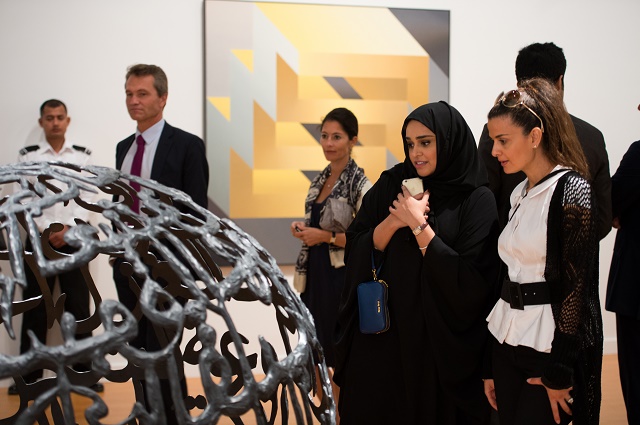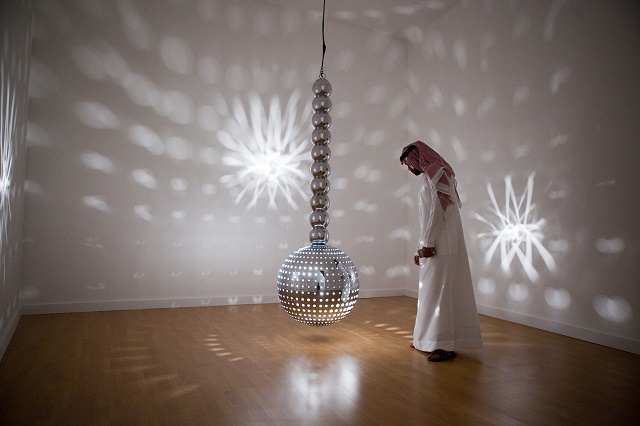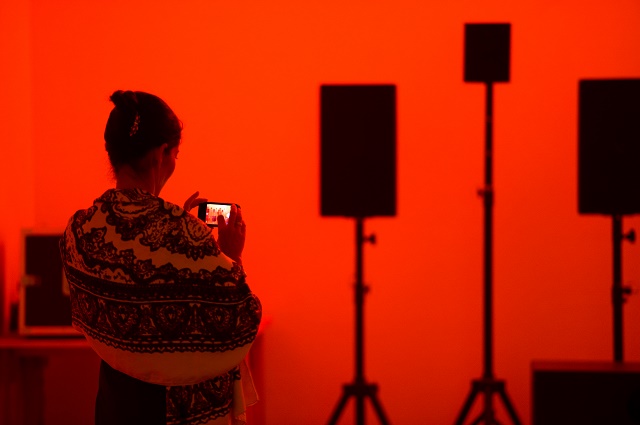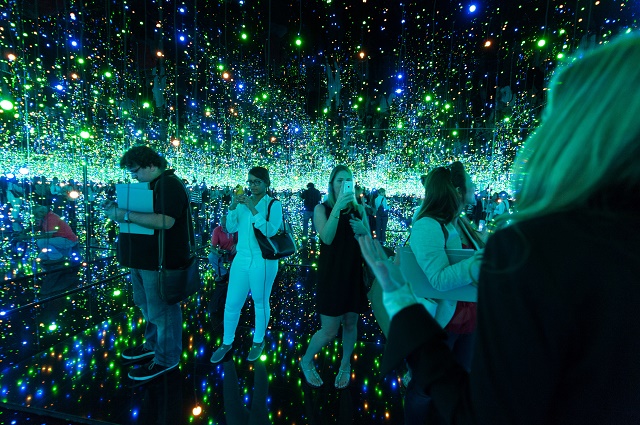“We believe the best vehicle for crossing borders is art. And this region is in need of such artistic initiatives,” said Mubarek Muhairi, director general of the Abu Dhabi Tourism & Culture Authority in 2007.
Today, Muhairi’s words certainly ring true as the emirate’s ambitious creative vision and cultural development plans to modernize and diversify its economy slowly come to fruition.
As recent as the 1950s, Abu Dhabi was little more than an unadorned desert inhabited by nomadic Bedouin tribes living in palm huts, deriving income from trade, pearl diving and fishing. Since 1962, when Abu Dhabi became the first of the emirates to export oil, the UAE capital has been transformed into a lush modern metropolis.
Emirati leaders’ recent efforts to reduce the country’s oil dependency and redirect the economy towards education and knowledge now have Abu Dhabi poised to become a major tourist destination and regional platform for global contemporary art and culture.
A citadel of the arts and global cultural exchange, Saadiyat Island – or “Island of Happiness” in Arabic – will soon house Jean Nouvel’s Louvre Abu Dhabi, British Museum-affiliated Zayed National Museum, an NYU campus, Zaha Hadid’s performing arts center, a maritime museum and the Frank Gehry-designed Guggenheim Abu Dhabi, developed by the state-owned Tourism Development & Investment Company (TDIC).
New ventures, new ambitions
Slated for completion in 2017, Guggenheim Abu Dhabi is one of three major museums financed by the Abu Dhabi government. And if the future museum’s pre-opening exhibition, Seeing Through Light: Selections from the Guggenheim Abu Dhabi Collection, is any indication of the museum’s potential in the region, the glimpse is certainly a promising one.
Spanning 450,000 square feet, the $800 million museum will be about 12 times the size of the Guggenheim in New York and showcase contemporary artists from the United States, Europe and the Middle East.
 According to Richard Armstrong, director of the Solomon R. Guggenheim museum and foundation, Guggenheim Abu Dhabi will examine art history produced around the world since the 1960s, focusing on themes and ideas rather than a chronological presentation.
According to Richard Armstrong, director of the Solomon R. Guggenheim museum and foundation, Guggenheim Abu Dhabi will examine art history produced around the world since the 1960s, focusing on themes and ideas rather than a chronological presentation.
“Let’s say that one of the ideas is what happened around pop art in the 1960s. Rather than saying this is 1964 and this is 1968, we’ve decided to show prime examples of this expression happening everywhere – in Cairo, New York, Los Angeles, London, Johannesburg, wherever,” said Armstrong. “So that rather a chronological presentation, we are looking at impulses and artistic visions that are happening almost at the same time around the world and therefore, you’re really getting a slice of creativity that has a global cast to it.”
Valerie Hillings, who has been with the project since its inception and is currently leading the Guggeneim’s curatorial team, explains that although the framework to trace art history around the world since the 1960s might seem daunting, they did feel it was an “incredibly watershed decade” for countries around the world in terms of art, history and culture.
“Within that giant field of all over the world since the 1960s, we began to look for the leading stories as well as some of the underknown stories in art history in different parts of the world,” said Hillings. “So we’re looking at major artists and art movements but also some of the unsung heroes of art history to try to imagine what that broader story might be. To that end, we are looking at what are the possible narratives and themes that we see running through art during this key period that we might use as part of the framework in thinking about the collection.”
Shedding light on Abu Dhabi’s creative ambitions
As a preeminent platform for global contemporary art, the addition of the Guggenheim to the emirate’s collection of museums is an important, strategic move to develop the country’s cultural sector to become globally competitive and collaborative in the world of fine art.
“It encourages Western museums to recognize and study modernism in the Arab world,” said Armstrong. “On an empirical basis, it allows students and people who would like to have a career inside a museum to be trained and become recipients of knowledge from professionals outside the country. So there’s a theoretical and image-based reform and a then there’s a reform based on career opportunities in the building of a cultural infrastructure.”
 The institution’s curatorial vision to create a transcultural perspective on modern contemporary art since the 1960s allows for the flexibility to explore cultural thought in an increasingly interconnected world while assembling and blending artists, various media and cultures in a way that almost challenges art-historical and curatorial canon.
The institution’s curatorial vision to create a transcultural perspective on modern contemporary art since the 1960s allows for the flexibility to explore cultural thought in an increasingly interconnected world while assembling and blending artists, various media and cultures in a way that almost challenges art-historical and curatorial canon.
Estimated to be one of the larger Guggenheim locations in the world, Hillings says the collection and programming for the Abu Dhabi museum will also take a strong and engaged focus on Asia and the Middle East “to find those leaders of artistic vision and cultural discourse and make sure they are visible with equal respect and interest.”
“There’s a total misconception that practically everything we’re looking at from the East is some new discovery. That history was always there and always as strong, even if it has different inflections from other parts of the world,” Hillings said. “Rather than thinking East-West, it becomes a challenge, curatorially, to present art from different times, different places and different artists. So one of the greatest challenges we are beginning to tackle is how to translate this vision into a practical display. We want to make sure that these distinctive histories are not washed away by just trying to look at formalism.”
Showcasing the Guggenheim’s local personality and potential
Using light as the only narrative in the collection, the Guggenheim’s Seeing Through Light exhibition opened at Manarat Al Saadiyat, a visitor center on Saadiyat Island, in November. It was also seen as the perfect opportunity for curators to showcase their transcultural vision of plurality across time and space.
 The exhibition includes the Yayoi Kusama’s popular Infinity Mirrored Room – Filled with the Brilliance of Life (2011), a blackened constellation of mirrors and water lit by handblown LED lights, a bronze sculpture by Egyptian-born Ghada Amer, a hanging light ball by Otto Piene, a painting by Egyptian artist Adel El-Siwi showing legendary singer Oum Kalthoum with a gold-painted face and works by western artists Doug Wheeler, Claes Oldenburg and Keith Sonnier.
The exhibition includes the Yayoi Kusama’s popular Infinity Mirrored Room – Filled with the Brilliance of Life (2011), a blackened constellation of mirrors and water lit by handblown LED lights, a bronze sculpture by Egyptian-born Ghada Amer, a hanging light ball by Otto Piene, a painting by Egyptian artist Adel El-Siwi showing legendary singer Oum Kalthoum with a gold-painted face and works by western artists Doug Wheeler, Claes Oldenburg and Keith Sonnier.
Dating from the 1960s to today, the works are divided into five sections exploring the different aspects of light – Perceptual, Reflected, Transcendent, Activated, and Celestial. While some pieces focused on immersing and engaging the visitor in specific, experience-rich environment, paintings, sculpture and video were also included in the collection.
“It is a stepping stone for what the future museum will come to be in 2017, where the art presented will be structured under the same transcultural perspective, manner and philosophy,” said Maisa Al Qassimi, co-curator of the exhibition. “The theme’s richness and flexibility has particular relevance across cultures and time periods, and will be presented as a primary aesthetic principle in the art world and history.”
Attracting more than 50,000 visitors since its opening on November 5, the exhibition has been extended until March 26 due to popular demand.
In addition to shining light on the creative vision of the future museum, the artworks and accompanying educational workshops also illustrate the museum’s ambitions to convey art as an experience, not just as a collection on display.
 “Our colleagues at TCA Abu Dhabi instigated a series of special needs tours and we were told that some special needs students went into the Hassan Khan piece that focuses on Egyptian music and there was this immediate letting free and dancing and engaging, so we realized that we are really tapping into and engaging different people. So the traveler carrying her tote bag in Long Island or the incredible joy and excitement of people taking selfies in the Yayoi Kusama piece has told us a lot,” said Hillings.
“Our colleagues at TCA Abu Dhabi instigated a series of special needs tours and we were told that some special needs students went into the Hassan Khan piece that focuses on Egyptian music and there was this immediate letting free and dancing and engaging, so we realized that we are really tapping into and engaging different people. So the traveler carrying her tote bag in Long Island or the incredible joy and excitement of people taking selfies in the Yayoi Kusama piece has told us a lot,” said Hillings.
Could the UAE become a global platform for contemporary art?
Given the success of Dubai’s art fairs, Sharjah’s long history with museums and Abu Dhabi’s gradually evolving art scene, Armstrong says the introduction of these institutions inside “what is already a very vibrant ecosystem,” the prospects of the UAE becoming a sought-after venue for art enthusiasts from around the world are “extremely bright.”
While the unique assembly of iconic museums side-by-side is already a significant achievement for Abu Dhabi, the sheer potential for future synergy, collaboration and art history education and research among institutions and cultures could catalyze the UAE’s already burgeoning art scene.
“The aspiration from multiple voices we are trying to embed in the [Guggenheim Abu Dhabi] is one that allows for different stories to be told,” said Hillings.
Given its location in the Middle East—as a central axis between Europe, Asia, and North Africa—Guggenheim Abu Dhabi and the UAE, for that matter, are both uniquely positioned to present art history from different vantage points in a revolutionary way, encompassing more than just art, culture and history, but emphasizing the reality of an increasingly interconnected world where creativity, innovation and threads of influence merge and connect.






























Inspiring for us to see what used to be unthinkable goals becoming reality in Abu Dhabi, UAE and the Middle East.
Just goes to show that if you dream big, you can achieve big.